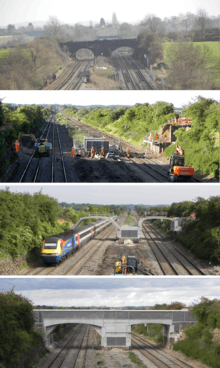Structure gauge
The structure gauge, also called the minimum clearance outline, is the minimum height and width of tunnels and bridges as well as the minimum height and width of the doors that allow a rail siding access into a warehouse. In addition, the term may apply to the minimum distance to railway platforms (passenger or freight), buildings, electrical equipment boxes, railway signal equipment, third rails or to supports for overhead lines from the track.[1] The width of a narrow cut can also affect the maximum loading gauge.


The difference between the structure gauge and the loading gauge is called the "clearance". The amount of clearance between the loading gauge and the structure gauge depends on the speed of the train, due to the train wobbling, so a train may be able to get past a restricted clearance by travelling at slow speed.
The term can also be applied to the minimum size of road tunnels, overpasses and bridges, as well as doors into automobile repair shops, bus garages, filling stations, residential garages, multi-storey car parks and warehouses.
Trivia
A 2 m (6 ft 6 3⁄4 in) high bridge near St Petersburg is known as the "Bridge of Stupidity" because it is often struck by vehicles despite many warning signs. In May 2018, after it was struck for the 150th time by a GAZelle truck, a birthday cake was presented to the bridge. This made national news.[2][3]
Similarly, a 11 ft 8 in (3.56 m) bridge in Durham, North Carolina, USA, was frequently struck by vehicles, and made the news a number of times until it was raised in 2019.[4]
Infrared sensors which trigger warning signs when a high vehicle approaches were added to an underpass in Frauenfeld, Switzerland only after several incidents.[5][6]
A similar situation exists on an underpass on Guy Street in Montreal.[7][8][9]
See also
- Air draft, applies to bridges across navigable waterways
- Berne gauge
- Clearance car
- Disadvantages of third rail (additional infrastructure restrictions)
- Engineering tolerance
- Loading gauge
- Railway platform
- Railway platform height
- Wayobjects
References
- "Structure Gauge and Kinematic Envelope".
- Plavskaya, Yelena (May 27, 2018). "Петербуржцы подарили «мосту глупости» юбилейный торт" [Petersburgers Give “Bridge of Stupidity” a Birthday Cake]. Izvestiya.
- "150th Truck Gets Stuck Under St. Petersburg's 'Bridge of Stupidity'". The Moscow Times. May 28, 2018.
- "In the news". 11foot8.com. 24 April 2019.
- "Unterführung wird jetzt deppensicher gemacht" [Underpass is Deepened]. 20 Minuten.
- Hilzinger, Stefan. "Kanton und Stadt entschärfen die Frauenfelder Deppenfalle" [Canton and City Defuse the Frauenfelder Deppenfalle]. St. Galler Tagblatt.
- Impact! New warning system on Guy St. underpass aims to reduce truck accidents, AMT train delays
- IMPACT in action
- Truck removed
External links
- Transport Canada, Standard Respecting Railway Clearance
- GLOSSARY OF TERMS USED IN RAILROAD HIGH AND WIDE CLEARANCES
- Railway line clearances and car dimensions including weight ..., Volumes 87-90
- www.ipm.fraunhofer.de/railway
- Clearance Guidelines for Industrial Railways (BC)
- Transport Canada